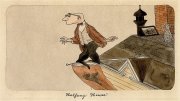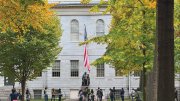"I rarely have to go to the libraries anymore," says economics concentrator Radim Rimanek '01. "I don't write many research papers, so I'm probably not in the library more than once a month." Yo-El Ju '01 explains, "The whole time I've been in college, I've always used the Web for research. I used to have to go to the library to look up things in indexes, and it was a total pain. Now you can search on-line to see if a paper on a given topic exists, and find out which journal has it, and which library. If you're lucky, the full text will be on-line." In the latter case, Ju can do her "library research" entirely on her laptop computer while relaxing at home in Adams House. "The libraries are nice and comfy," she says, "but a lot fewer people go."
If so, those few are using the libraries more heavily than ever. "The use of the building [Lamont Library] and interest in our collections is as high as it ever was, and growing," says Heather Cole, librarian of Hilles and Lamont Libraries. Lynda Leahy, associate librarian of Harvard College for research and instruction, reports that undergraduates' borrowing of books from Widener rose by 42 percent between 1990 and 1999. Circulation figures for Lamont, the core undergraduate library, have also climbed in recent years, from 161,000 in 1997-98 to 179,000 in 1998-99 and 183,000 last year. Students now use the reserve materials "more than ever," according to Jeff Kosokoff, Lamont's head of reference.
The seeming paradox of more on-line research from home and more consultation of library materials rises from the deep ways in which electronic research tools are changing the practice of scholarship. Electronic indexes, says Leahy, are "launching pads that help students find other kinds of information." Kosokoff explains, "Harvard has a vast collection, but things were harder to find before electronic indexes. Now, once you've done your search on-line, we tend to have a huge percentage of what's indexed. Although IBM would have us believe that everything written is on-line, the fact is that a very small percentage of material is available electronically--especially anything older than three or four years." In disciplines like Ju's field of concentration, neurobiology, the immediacy of electronic information is essential. "So much new stuff comes out each week--there's no way I'd be able to keep up if I couldn't search indexes on-line," she says. But in the social sciences and especially in the humanities, the pace of change is slower, and printed books still hold sway.
Nationally, during the last decade, research libraries have seen a decline in the number of users' reference questions "due to the burgeoning number of electronic access routes and materials," according to the Association of Research Libraries. At the same time, users are asking more complex, sophisticated questions driven by the bewildering array of database options. Harvard libraries show this same trend, writ large. Use of electronic resources at Harvard is heavy--well above the average rate for other "very large" research libraries, says Leahy. Harvard librarians consult with students not only about HOLLIS, Harvard's digital library catalog, on-line since 1985, but even more about Hollis Plus, whose portal page has opened a wealth of electronic resources to the University community since its 1994 debut. "When I'm working with students, they'll tend to know about [the broad-based on-line indexes] Lexis-Nexis and ProQuest," says Steve Love, reference librarian at Hilles Library. "But they're often not aware of the next tier, specialized databases like Sociophile for sociology and Historical Abstracts for world history."
"In the old days, someone beginning a research project would come to the library first--perhaps after asking people they know about the topic and consulting their personal libraries," says Kosokoff. "But today, that personal library includes the Internet. When we see them, it's much later in the process; they are at a more advanced point in their research. They come to us when they've hit a dead end. We get fewer questions, but they take much longer to answer."
"Librarians are becoming teachers," says Cole. "We're showing students how to navigate and search in this electronic environment. The glut of information that college kids face is more enormous than they realize. And they're not necessarily coming in with good tools for doing this research." Love says he often helps undergraduates refine and narrow searches that have retrieved too much material, or expand and target those that haven't found enough.
Quality as well as quantity is at issue. Professor of biology Ken Boss, for example, has noticed a new pattern of scholarly citations in student papers. "The last few years, things have dramatically shifted; it's getting so that students are citing more websites than books," he says. "Some people rely almost totally on the Web. But there's no quality control--anybody who wants to can put up their own site. There's a lot of intellectual noise on the Web."
Kosokoff elaborates: "Now, you can very quickly get a long bibliography on most topics. But finding something easily doesn't mean it's the best source." The library itself performs one level of screening; the resources on Hollis Plus, for example, have passed muster with the Harvard College Library, which has found them worthy of their subscription fees. As Kosokoff puts it, "We bought quality resources."
The library has also been taking steps to empower its users electronically. Library patrons can now renew books, ask reference questions, and request interlibrary loans on-line. Lamont offers students "loaner" laptop computers, and has introduced "roaming technology" that enables a student to plug his or her own laptop into a data jack, or connect to the Faculty of Arts and Sciences computer network. There is also material on "electronic reserve," including video formats. ("The use of visual materials across the social sciences and humanities is increasing dramatically," says Cole.) Electronic reserves can include articles, images, or scanned data; students "can click on it at 3 a.m. and read it on-line instead of checking it out of the library," Leahy explains. In some cases, to satisfy publishers' licensing requirements, the library restricts reserves' availability to its local area network or to a list of students registered in a course, whose Harvard ID numbers serve as passwords. The library is also greatly expanding its instructional programs.
Much of this may seem new, even revolutionary, but for most of Harvard's librarians, the innovations and challenges of digital technology are simply added ways of carrying out their time-honored tradition of enabling students and scholars. "We've always taught," says Kosokoff, "and we've always been in the information literacy business."





